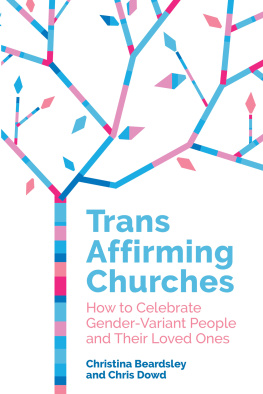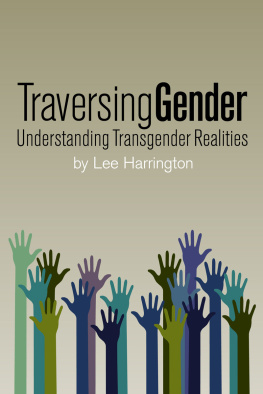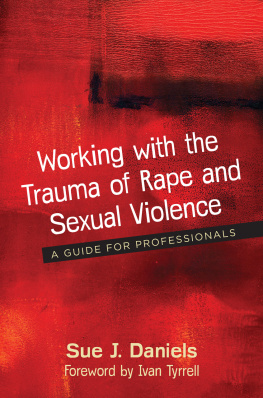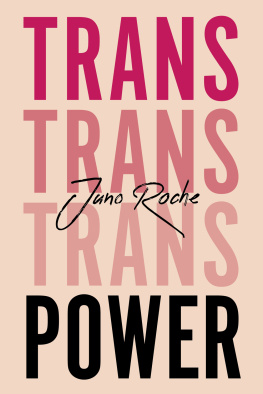
Working with
Trans Survivors of
Sexual Violence
A Guide for Professionals
Sally Rymer & Valentina Cartei

Jessica Kingsley Publishers
London and Philadelphia
Contents
Ch 2: Violence
Experienced by the Trans Community
Introduction
Research on trans peoples experiences of sexual violence people may confront similar, if not higher, levels of sexual violence and abuse (James et al. 2016; McNeil et al. 2012; Grant et al. 2011).
The devastating effects of sexual violence on individuals, including trans individuals, can be mitigated by effective responses from health and well-being professionals and organisations. Professionals are also in a frontline position to act and prevent abuse. However, professional courses in the health and sexual violence support sectors do not usually provide specific training about working with trans individuals or communities. In addition, due to the interpersonal betrayal and complex effects associated with sexual violence and abuse, as well as previous experience of discrimination experienced in response to their gender identity and expression, many trans people are unlikely to raise the topic on their own. These factors often leave professionals lacking skills and experience in talking about sexual violence with trans individuals and working with them to help them heal.
This book focuses on building the capacity of professionals and organisations as means of bolstering systems of accountability for sexual violence and facilitating recovery for trans survivors. Many of you will work in mainstream services which serve primarily cisgender people, but may occasionally find yourself working with trans clients. Some of you who will find the book useful will work in specialist organisations that focus on trans people, some of whom may have experienced sexual violence.
Our interest in the needs and experiences of transgender survivors arose when we were both involved with Survivors Network, the Rape Crisis Centre for Sussex, which is based in Brighton & Hove, a city well known for its large lesbian, gay, bisexual and transgender plus (LGBT+) population. The trans community has a visible and vibrant presence locally. Following a trans awareness training session for staff and volunteers of the Rape Crisis Centre, we wanted to understand more about how our centre could better meet the needs of the trans survivors in our local area. We found that very little research on this topic existed, so in 2015 we conducted research with trans survivors and the professionals working with them, to explore specific barriers for trans individuals in accessing support within the United Kingdom (UK) after an experience of sexual violence (Rymer and Cartei 2015).
Through this research, we learned first-hand some of the challenges that trans survivors were facing as they struggled to access mainstream and specialist services. Our conversation turned to how we could draw on trans survivors experiences, and on our own experience of working with survivors, to improve the response of service providers and professionals so that trans survivors needs were heard and responded to. As part of this work, we have been involved in establishing a national helpline for trans survivors of sexual violence, which will be discussed in more detail in .
It is against this backdrop that the idea for this book came to be. In fact, many of the themes and suggestions for best practice developed in this book stem directly from the stories shared by those who took part in our study, as well as those who we had the privilege to work with in the years that followed. You will find in this book many quotes from trans survivors who contributed to our original study. You will also find anonymous quotes from trans survivors who contributed to a survey specifically for this book. Their contributions can be found in the Trans voices boxes throughout this book. We would also like to recognise the valuable contributions of other organisations, researchers and activists on this topic. Rape Crisis Scotland, for example, has taken a keen interest in supporting trans survivors and has developed guidance for other Rape Crisis Centres on the inclusion of trans women in womens services (Rape Crisis Scotland 2011). Forge, a charity in the United States (US), has conducted valuable research into the experiences of trans survivors and has produced useful guidance documents for professionals who work with them (munson and Cook-Daniels 2015, 2016).
Weaving together survivors accounts with professional knowledge and best practice, this book aims to provide clear explanations, practical suggestions and support for professionals and organisations that want to make their services more inclusive for trans individuals who have experienced any form of sexual violence or abuse, no matter how or when it happened.
: An Introduction to Trans Identities will be helpful for professionals who would like to start or increase cultural competency in trans issues. It offers an introduction into different trans identities as well as the transition process, and the differences between sex, sexuality and gender. It also gives you tools you can use immediately such as dos and donts for behaviour and language.
In order to specifically address our interest and rationale for this book, : Violence Experienced by the Trans Community outlines the multiple forms of disadvantage and oppression faced by many trans people, including increased vulnerability to sexual violence. This chapter will provide insight into the intersectional discrimination and violence faced by the trans community. Understanding the level and impact of these experiences of violence, both on the individual and on the whole trans community, is essential in understanding the barriers that trans survivors face when accessing services and how organisations and professionals can best support trans survivors.
means when human suffering becomes trauma, and ends with an overview of common responses, with reference to neurobiological processes explained in accessible language. It also looks at individual and societal factors that may influence the impact of, and recovery from, trauma, emphasising that individuals experience sexual trauma in different ways, and one path to recovery and healing that is right for one person may not necessarily be right for another.
While trans people appear to be at a particularly high risk of sexual violence, they may also find it more difficult to access services that would be able and willing to support them in their recovery. : Problems with Accessing Mainstream Services looks at why it is often difficult for trans people to access services from specialist organisations and generic providers in the aftermath of sexual violence and how those services can become more inclusive of trans clients.
The two chapters that follow include recommendations for all levels of service delivery, from organisational policies ( : Best Practice: Individual Practitioners ) so that your communication can be positive, non-stigmatising and successful. These chapters also contain practical tools, such as an accessibility audit, and key advice for different professionals.
In the final chapter, the current service provision landscape, which mostly serves binary gendered people.
Some chapters may offer suggestions or recommendations that appear in more than one chapter or reference another chapter. In these cases, the topics are distinct enough, in our opinion, to warrant separate chapters, despite the fact that some of the same recommendations could apply to all. In other cases, recommendations are omitted from chapters if they are already noted in some other chapters; readers are directed throughout the book on appropriate chapters to cross-reference and review. This book is designed ideally to be read in full, cover-to-cover, but it is also possible to dip into chapters that seem particularly relevant to your specific work.
Next page










